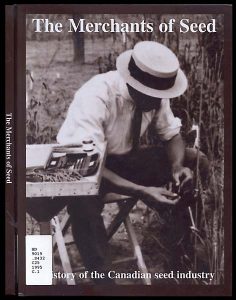NOTE: This story comes with an accompanying podcast — scroll to the bottom of the page to listen!
For 95 years, the Canadian Seed Trade Association has helped lead the way in a shifting Canadian seed landscape.
Being a 95-year-old organization, it’s no surprise that the Canadian Seed Trade Association (CSTA) was a product of its time and place. In the early 1920s, the seed landscape looked much different than today.
“Seed production in the early part of the last century was largely focused in Ontario, including forage seed production,” notes Dorothy Murrell, former CSTA president and currently the project director for the University of Saskatchewan’s Livestock and Forage Centre of Excellence.
At the time, the federal government and its agriculture minister, William Richard Motherwell, were looking for an advisory board to advise them on matters pertaining to the Canada Seeds Act. The CSTA was officially formed in 1922 to provide such an advisory board.
The association began to expand its influence, and in time went from an advisory role to the function it serves today — as a major voice for the Canadian seed trade.
It now represents over 130 member companies in all matters pertaining to all aspects of seed research, production and marketing, both domestically and internationally.
As Canada’s agriculture industry became more varied and began spreading out, the CSTA adapted to suit the changing times, Murrell notes. The seed industry gradually expanded into the Prairie provinces. Seed companies were set up in Western Canada to process and sell seed.
In the 1940s, the CSTA expanded to form eastern and western seed trade associations. A consolidated convention in the 1940s was where the tradition began of having CSTA presidents alternate between East and West.
“That tradition continues today, serving to help in maintaining strong linkages between Eastern and Western Canada,” Murrell says.

The CSTA office moved from Winnipeg to Ottawa in the early 1980s, and remains based there today. Membership ranges from those who market garden seed and herbs to large western grain handlers, and from small family-run businesses to large multinational corporations. The seed products come from about 50 principal crops, including grains and oilseeds, special crops, forage and turf grasses, flowers, vegetables and fruits.
Its executive director, Crosby Devitt, recently announced he’s leaving the organization to serve as vice-president of the Grain Farmers of Ontario. As CSTA looks for his replacement, he looks back on the last two years he spent in his role with CSTA.
“Generally, if you look at how agriculture has changed, the seed industry has changed a lot and has a lot of influence on how agriculture looks today in Canada. The crops we grow today are different than the ones we grew 100, 50 or even 20 years ago. One example is canola,” Devitt says.
“Fifty years ago, CSTA wouldn’t be working on canola, but now we have major effort around this crop. We work based on the wishes of our membership. That’s the kind of flexibility that has helped us be successful over almost a century of being a major voice in this industry.”
“Major voice” would be an understatement. CSTA has evolved over the years to form a strong committee structure dedicated to dealing with a number of issues concerning the seed industry in Canada. It has committees for biotechnology; forage and turf; corn, soybeans and eastern cereals; intellectual property; oilseeds, pulses, and western cereals; seed-applied technologies; international issues; eastern and western researchers; and stakeholder relations.
While CSTA has changed to suit a changing agricultural landscape, its membership has changed right along with it, Murrell notes. When it was founded, members consisted largely of small, independently owned seed companies. In the age of consolidation, that has shifted.
“Over the past 20 years especially, seed businesses have merged, closed, been sold and bought. Membership of the CSTA has gradually shifted to encompass more large and multinational companies,” Murrell says.
“A big driver for that change was the increase in private sector plant breeding and along with that, the engagement of largely private sector companies in biotechnology.”
Small- and medium-sized seed business continue to make up more than half of the CSTA members, which ensures that the organization represents all facets of the industry.
Technology is adopted quickly in agriculture, Devitt notes, and changes within CSTA are a direct reflection of that.
“If you look at ag technology and how farmers farm, that’s evolved really fast — precision seeding, GPS, that sort of thing. That influences the direction we go in as an association. Our members are leading a lot of those changes on-farm. Add to that the whole development of new varieties and the technology associated with that, and that’s changing the CSTA as well.”
CSTA has used that forward momentum to help move the seed trade forward. It played an important role in the adoption of UPOV 91 in 2015.
“That’s a huge step change. Biotechnology has become hugely important in the seed industry, and processes surrounding it have had to be developed quickly. Trait development organizations have became very engaged in the seed industry, and this has generated a new way of looking at seed,” Murrell says.

“It also gradually formed the basis for placing even more importance on plant breeding, as it became clear that once traits were developed we still needed to pay attention to genetic improvement itself.”
There are many common issues that speak to the membership, right across crop kind and functionality, she adds.
“Members are interested in seeing solutions to problems. Whether it’s a single owner-operator or a large multinational, the regulatory environment affects them all. Consolidation means some of the dynamics may have changed, as many of the people at CSTA meetings and other events may not actually own the company they represent, but the people in the room are still very much engaged.”
Changing Dynamics
Membership engagement has become even more pronounced as time has gone on, Murrell says, as technology allows more effective and faster communication than ever.
“The seed industry is more complex than it was. The world is more complex, or at least we get more information now, which makes it seem more complex. It’s sometimes difficult to filter things out and figure out what’s meaningful.”
Despite that, CSTA has continued to manage the issue of seed trade very effectively, she says.
“While seed trade competition can be very fierce, nevertheless, there are strong friendships across the seed trade built on mutual respect and shared dedication to the industry.”
Devitt adds: “That allows us to work together. There’s a compatibility built in, and that will only get stronger as we go forward as an industry.”
The need for effective communication with members and, at the end of the day, with the federal government, is more important then ever for CSTA, Devitt says. An example of that is the ramping up of a communications strategy a few years ago and the formation of the stakeholder relations committee to shepherd and steer communications vehicles for the association.
“Is our system equipped to handle future technology? Is it based on the past and not the future? If we can’t get new products to market the way we want because our regulatory system has a bottleneck in it and we’re unsure of how to handle it, that will slow down our innovation and affect our competitive advantage globally,” Devitt says.
“How do you build something for the unknown? That’s an area we need to look ahead to.”
Murrell concurs, noting that there were once only three representative groups that made up the seed industry — CSTA, the Canadian Seed Growers’ Association, and the Commercial Seed Analysts Association of Canada. In recent years, CropLife Canada, the Canadian Seed Institute and the Canadian Plant Technology Agency were added to the roster.
“When someone in government needed to speak to someone with regard to seed production, they went to one organization. For issues around varietal purity, they went to another. If it was about trade, they went to the third. Now there are six, so it’s a little more complex,” she says.
—with the assistance of Neil Arbuckle, Scott Horner, Bill Leask, and Jeff Reid. Read The Merchants of Seed CSTA history book at¬†http://www.ourroots.ca/toc.aspx?id=6118&qryID=340f13e2-ea00-4827-8759-c94789bd0d29.
—The¬†Past, Present, Future series examines each of our sector’s six representative groups over the next several months to offer insight into why¬†they were founded, what they do, and the role they expect to play in the future.













